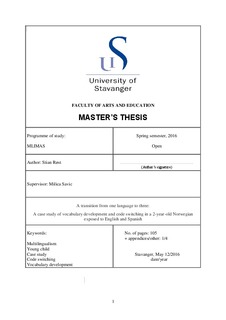| dc.description.abstract | The longitudinal case study of Mia (pseudonym), a two-year-old, investigates different aspects of language development during a six month transition from being monolingual in Norwegian to becoming an emergent trilingual, with English and Spanish as the new languages. The main focus of the study addresses her passive and active vocabulary development in English and the features of code switching in the child’s language.
Even though research on multilingual children has increased, the number of such studies is still limited both in number and variation (Baker, 2011; Edwards and Dewaele, 2007). Previous research in the field of bilingualism and multilingualism in young children has mainly focused on children that have been raised bilingually and multilingually from birth (De Houwer, Bornstein and De Coster, 2006; Hoffmann and Stavans, 2007; Lanza, 2004; Montanari, 2009; Poulin-Dubois et al., 2012) or that have been exposed to one new language after the establishment of one or two first languages (Edwards and Dewaele, 2007; Vihman, 1985; Wei and Hua, 2006). The current study aims to contribute to this field of research by investigating a new language combination (Norwegian, English and Spanish) and a different developmental sequence, that is, simultaneous exposure to two new languages at the age of two.
The current case study lasted for six months, and was initiated at the same time as the exposure to the two new languages started. The data for the investigation was collected at several stages in various contexts that were characterized by differences in both the language (combinations) used and type of social environment. A combination of audio and video recordings made at home and in the preschool, conversations with the child’s caregivers, field notes made by the researcher, and questionnaires (Child Development Inventory) completed by several caregivers formed the foundation for exploring Mia’s vocabulary development and code switching in the study.
The findings of the study indicate that both Mia’s passive and active vocabulary development was largely influenced by the way language was used by her caregivers, and by the need she had for the different aspects of the different languages in the social settings she participated in. As a result, the majority of the words Mia acquired were words that she needed in routines and activities she participated in at home and in the preschool. Most of the acquired vocabulary items in her passive and/or active vocabulary were content words, and the few function words she acquired were mostly those that could convey meaning on their own, such as the quantifier more. Besides, in spite of more exposure to English than Spanish, the findings indicated that her passive Spanish vocabulary had developed more than her passive English vocabulary, while no substantial differences were found in her active vocabulary development.
With regard to the findings concerning Mia’s code switching, all of her code switches were intrasentential, and the majority of them were insertion of English nouns into sentences with a Norwegian structure. There were very few trilingual code switches, contrary to the claims that they are very unlikely to appear (Hoffmann, 2001; Widdicombe, 1997), they did occur. As for the functions, the code switches were mostly a result of Mia copying an adult’s speech, and a small amount of the code switches were results of adult prompting of specific language use, and Mia’s wish to reinforce requests. The features of her code switches may provide evidence for the development of multicompetencies (Cook, 1992; Grosjean, 2008), metalinguistic awareness (Hoffmann and Stavans, 2007) and language system differentiation (Barnes, 2006; Meisel, 1994) even after six months of exposure to the new languages. | nb_NO |

